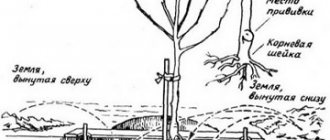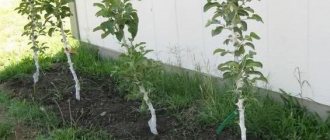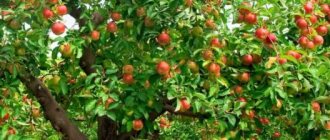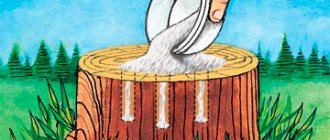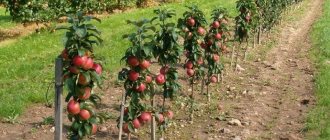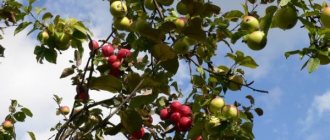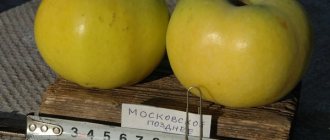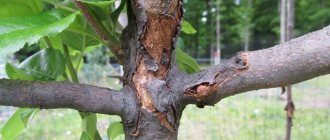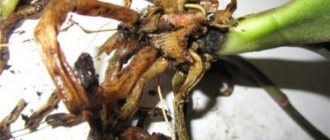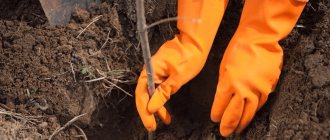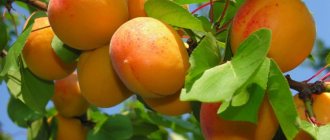Aboveground part of the apple tree
The aboveground part of the fruit tree consists of a trunk and a crown, which, in turn, has many different formations within itself.
- The stem is the part of the trunk that is located between the root collar and the first lateral shoot. When purchasing a seedling, you need to pay attention to the condition of the trunk: it should not show any damage in the form of violations of the integrity of the bark, smudges and signs of frostbite.
- Crown - the totality of all branches on a tree.
- Shoots are annual new formations consisting of stems and leaves.
- Leaves are the green part of the tree where many important processes take place, such as photosynthesis and gas exchange. This element can have different shapes and colors depending on the type of apple tree.
- The forming branches are divided into many subspecies and components.
Let's look at what the forming branches consist of:
- Fruit twigs change every season, their length does not exceed 15-20 cm, the apical bud is flowering (reproductive), and the lateral buds are vegetative.
- Spears are annual shoots, the length of which ranges from 2 to 15 centimeters. The lateral buds are vegetative, the apical bud can be either reproductive or vegetative.
- Rings. The age of such branches can vary from 1 to 5 years, their size is no more than 5 centimeters, the lateral processes are underdeveloped.
- Fruitlets arise as a result of the formation of fruit bags after the flowering of ringlets. They are perennial (from 3 to 6 years).
- Fruits are the oldest formations (from 6 to 18 years). They are formed from ringlets, fruitlets and fruit twigs.
The difference between reproductive and vegetative buds is that some form flowers, while others form shoots and leaves. As a rule, fruit buds are large and round.
What is a root collar
The root collar is the conventional place of transition of the root into the trunk. It is the most vulnerable and unprotected place of the tree due to its unique structure and location. The structure of its cambium, wood and bark differs significantly from the structure of the entire tree - it is in this place that the main element of the conducting system of the underground part passes into the above-ground part. The main function of the root collar is to regulate the nutrition, growth and development of the apple tree.
Appearance
The root collar can be identified by the following characteristics:
- the bark of the root collar of an apple tree is usually somewhat darker than the bark of the trunk;
- located 5–7 cm below the graft, which is usually easily identified by its characteristic influx or thickening and stands out on the trunk;
- the distance from the uppermost root to the conventional border of the beginning of the root collar is 2–4 cm;
- in some cases it may have a thickening at the bottom.
Peculiarity
The location and structure of the root collar makes it quite vulnerable:
- freezing of the fabric occurs when frost occurs and there is no snow cover;
- during temporary flooding due to lack of air, it becomes wet;
- in deep snow cover, when the temperature rises, the bark becomes damped out;
- easily susceptible to sunburn;
- accessible to pests;
- the root collar affected by weather conditions is more susceptible to fungal diseases, which, in turn, develop much faster.
To preserve the apple tree, it is necessary to pay special attention to this area - to take protective measures against freezing, disease and pest damage, as well as to ensure free access to air and diffused sunlight.
Biological description of the apple tree root system
The root system of an apple tree is not much different from the systems of other trees, both in structure and function. Thick skeletal roots extend from the root collar, from which processes of the second order are formed, and from them - of the third. The further away the branching is, the thinner and smaller it is. The most distant part is called the overgrowing part, and the thinnest formations are called the “root lobe”.
The young part of such branches is the most important in the structure and life of the tree. It is covered with thick, thin hairs that actively seek and absorb water, providing all parts of the apple tree with this resource.
How to help a dying apple tree
Before cutting down a plant, you need to try to save it. If the roots of the apple tree are in water, you can try to drain the area using drainage pipes that are laid underground. Through them, excess water flows into a well dug outside the garden.
Drainage ditches up to 1.5 meters deep can be dug along the boundaries of the site, along which water will flow into a special well.
Water drainage diagram.
Trim all tree branches thicker than 1.5 cm in diameter and the central conductor, removing the load from the roots. Raise a young plant up to 7 years old to soil level. You can try to regraft the apple tree.
Saplings with open root system
An apple tree, the type of root system of which is characterized as open, before planting consists of an aerial part and bare roots. Seedlings of such trees are easier to inspect and see flaws.
To avoid buying a low-quality plant, you need to consider the following factors:
- The roots should be white and have shoots in all directions.
- An important indicator of quality and health is the absence of mechanical damage and flexibility.
- Overdried roots that crack at the bends most likely will not take root in the new place.
- A small number of lateral shoots or their absence may indicate an older seedling; such material is unlikely to take root or will suffer a lot.
- If swelling is visible on the roots, then most likely the tree is infected with root canker.
- Apple trees with an open root system cannot be left without soil for more than 2 weeks. Therefore, it is very important to pay attention to the date the seedling is delivered to the store.
A properly developing root system of a tree is the key to the plant’s successful passage through its entire life cycle. Since the normal development of the root is ensured by the quality of the soil, and its upper and lower layers into which the roots grow, caring for plant roots in practice consists of caring for the soil, which is the environment in which the growth and development of the root system occurs. Knowing exactly how the underground part of each type of fruit tree is located in the soil is very important for a gardener - this information will allow you to properly care for the plants and maintain a depth of soil cultivation that would not lead to damage to the roots, especially the suction ones. Knowing the area of the periphery of the tree trunk circle, the gardener will be able to rationally apply fertilizers - they will immediately end up in the area where the most active roots of the tree are located, as well as correctly perform root watering.
Content
- Structure of the root system
- Dimensions of the root system - on what factors they depend
- Apple tree
- Pear root system - video features
- What types of fruit trees should be preferred?
- Root system of seedlings video
Structure of the root system
The root system of plants, in particular fruit trees, is their underground part, including the root collar, skeletal roots and overgrowing roots. The place where the root passes into the stem is called the root collar; its color is transitional; the color between the above-ground and underground parts of the plant changes smoothly. Only trees that have grown from seeds can have a true root collar; plants propagated by cuttings or layering have a false root collar. When planting fruit tree seedlings, remember that the root collar should be located above the soil surface.
The primary root and all branches extending from it take part in the formation of the skeletal structure of the root. The purpose of skeletal roots is to supply the tree with nutrients during the warm season and to store nutrient reserves in winter. Skeletal roots also serve to strengthen the plant in the soil. The shoots they produce are a natural way of plant propagation.
The root lobe of a tree is formed by overgrowing roots; it represents the most active part of the system, serving to absorb and absorb moisture and nutrients from the soil and transfer them to skeletal roots.
Types of tree root systems for placement in the ground can be:
- vertical
- horizontal.
Dimensions of the root system - on what factors they depend
If growth conditions are satisfactory, then the size of the tree's root system can be quite large. In fruit trees, roots can penetrate to a depth of 3-4 m, and they can branch out to a width of 5-8 m. But in most cases, the most active part of the root system is located at a shallow depth, about 0.2-0.8 m.
It should be noted that the growth of the root system of fruit trees is an uneven phenomenon; two waves of increased growth can be observed throughout the year: in autumn and spring. It is interesting that in the spring the above-ground part of the tree comes to life earlier, in the fall - first the growth of shoots stops, then the leaves fall off, the growth of roots continues for some period after the leaves fall.
The rapidity of the increase in the size of the underground part of the tree depends on the temperature of the soil, its saturation with moisture, air, and nutrients. The optimal soil temperature for growth is considered to be from +7 C to +20 C; when the temperature drops below 0 or rises to +30 C, growth stops. The roots of shrubs and trees suffer from a strong drop in temperature to a greater extent than the crown. Therefore, in frosty winters, the root area should be covered with peat, snow, and spruce branches.
The level of soil oxygen saturation largely depends on the looseness of the soil; excessive moisture, especially stagnant water, also has a negative effect on it. Inhibition of root growth is caused by a lack or excess amount of nitrogen compounds in the soil. Potassium and phosphorus are beneficial for the tree - they stimulate root branching, and calcium gives strength. The size of the tree root system also depends on the type of rootstock. It is possible to increase the mass of roots below the arable horizon through certain agrotechnical techniques, for example, plantation plowing.
Typically, the depth of the root system of fruit trees is from 20 to 60 - 75 cm. As for the horizontal direction, they are much higher than the projection of the crown onto the ground. The measles system of plums and cherries have a similar occurrence pattern.
Apple tree
The root system of the apple tree is somewhat different, the bulk of the roots are located at a depth of 50 to 60 cm, some groups of roots penetrate much deeper, up to 4 m. The northern regions are characterized by a shallower root system. For example, if the soil is damp and heavy, then the depth may be only 20-25 cm. But for the climatic zone of the North Caucasus, this figure will be about 7 m; if the radius of the crown of such an apple tree is 1.5 m, then the lateral the roots can be spread out horizontally within a radius of approximately 3.5 m.
The depth of the network of small roots for such a tree will be in the range of 50-60 cm.
Pear root system - features
The pear tree has vertical and horizontal root systems, the roots of the first go to a considerable depth and have practically no branches, the roots of the second, parallel to the surface of the soil, are very branched, but at the same time they have a compact arrangement and extend slightly beyond the crown projection. The horizons of the root system of pear trees are located in deeper horizons than the roots of apple trees. This is why pears are not inclined to sprout; this phenomenon is much more common in apple trees.
The largest number of pear roots lies at a depth of 20 cm to 160 cm, and skeletal roots can grow to a depth of 5 m. A pear with a rounded crown has a root system that is usually wider and denser than that of pyramid-shaped trees. The activity of growth and placement of the root system in space is influenced by:
- rootstock,
- characteristics of the grafted variety,
- environmental conditions,
- tree age,
- climatic conditions,
- correct landing.
One of the peculiarities of the pear should also be remembered that when transplanting, it reacts very painfully to pruning the roots. The crown, sensitive to the state of the root system, begins to fully develop only in the second year after transplanting the plant, and then only in the case of restoration of the root system. A tree with severely damaged overgrowing roots is practically doomed to death.
What types of fruit trees should be preferred?
Numerous studies show that the size of the root system of fruit trees, starting from the second year and beyond, is approximately 1.5 - 2 times larger than the projection of the crown diameter. Moreover, this proportion is observed in trees of different species growing in different climatic conditions. At the same time, with the shift of the gardening zone to the south, a deepening of the underground part is observed. But with a high groundwater level or the presence of dense pebble layers in the soil, trees in the southern regions can also have a shallow root system.
When choosing a tree species, you should give preference to one that has roots that are uniform around the circumference, as deep and wide as possible, allowing you to obtain the maximum amount of moisture and nutrients from the soil. A plant that meets these requirements will be highly frost-resistant and drought-resistant. In addition, the lifespan of such plants will be longer, and their fruiting will be regular. Also, when planting a garden, you should take into account what kind of root system the trees planted next to each other will have - Darwin proved that there is intense competition between plants of the same species when growing together, but this is absent in plants of different species. Also, more active spread of roots will be observed towards the growth of a weaker neighboring tree.
Root system of seedlings
Since the development of a tree’s root system determines its life expectancy and the quality of fruiting, when purchasing seedlings you should pay close attention to the roots. When buying a tree with an open root system, you need to make sure that it is sufficiently developed and dense. The tips of the roots should have a whitish tint - such plants were recently dug up and their roots are still growing.
Trees you should not buy:
- with blackened and dried roots,
- with growths on the roots,
- with twisted, deformed roots.
You should be careful with trees with limp or dry foliage - perhaps the plants were kept unrooted and their survival rate could be significantly reduced as a result.
Author: Sergey and Svetlana Khudentsov
10
Choosing a place to plant an apple tree
When choosing a place to plant an apple tree, regardless of the type of root system, you need to adhere to the following rules:
- The area should be well lit, so there should be no tall or spreading trees nearby.
- It is advisable to choose a place where there will be no strong and gusty winds.
- Apple trees are best located in a separate area for this crop; proximity to other fruit and berry plantings is not encouraged.
- To provide trees with high-quality pollination, it is customary to plant different varieties next to each other, differing in their fruiting period.
Planting an apple tree in autumn
The root system of the apple tree must become stronger so that the tree can begin to bear fruit. Therefore, when choosing a time for planting, many gardeners opt for the autumn period. This method is suitable for southern regions or for seedlings with a closed root system. It is customary to carry out this work from the end of September to the beginning of October, and the soil should be loose and allow air and moisture to pass through.
- About a month before planting the seedling, you need to dig a pit 70-80 cm deep and 1 meter in diameter, the fertile layer of soil must be separated and set aside.
- In order for the future apple tree to have support, you need to dig a peg, which should protrude 40-50 centimeters from the ground. To prevent the lower part from rotting, it is pre-burnt.
- The soil should be as fertile as possible, so you need to pour a mixture of humus, manure, compost, peat and fertile soil layer, which was removed in advance, into the pit.
- During planting, you need to make a shallow hole in which the roots of the tree are placed, then they need to be sprinkled with soil. In this case, the root collar should protrude 5 centimeters from the ground.
- Then you need to tie the seedling to a peg and water it generously.
- On average, the distance between trees should be 3-4 meters. When choosing a planting scheme, you need to pay attention to the variety of apple tree.
Planting in spring, autumn
Previously, there was an opinion that apple trees should be planted only in the fall.
Well, today we are planting them:
- In spring - before the soil warms up (buds open).
- In autumn - how the leaves fell off. Try to plant at least 25-30 days before frost
You will determine the exact time when to plant it yourself, because conditions vary even on neighboring plots, not to mention villages and dacha communities. The main thing is the condition of the soil and weather.
The choice of apple trees depending on the groundwater level.
I can say from my own experience that it is not very pleasant to plant in drizzling rain or dig in with wet soil.
If you have purchased seedlings, but the weather does not allow them to be planted, dig them in until suitable conditions arise, and maybe until spring in a quiet place.
General landing rules:
- Plant quickly, do not let the roots of the seedling dry out, and before planting, moisten them in the so-called clay mash, or even with water.
- Distribute the roots evenly over the prepared planting hole or mound.
- Cover the roots with loose soil, not stones.
- Lightly trample or tamp with your hands, do not leave gaps between the roots.
- Make holes for watering. Water 2-3 buckets.
- Sprinkle the holes with dry soil, compost, grass, and pine needles.
- Insert the stake and tie up the seedling.
- Do everything carefully and carefully so as not to damage the roots.
But if the water (above 1.0-1.5 m) does not allow planting in the generally accepted way, and you really like apple trees, additional work is inevitable.
Planting an apple tree. A properly planted apple tree.
Some methods and techniques have been tested in practice:
- Landing on equipped artificial hills height of at least 60 cm and width of at least one meter:
- a mound separately for each seedling;
- a series of mounds;
- better with wooden boxes.
Landing on earthen mounds. - Planting on earthen ramparts, ridges.
- Planting with the equipment of so-called concrete pads.
- Landing on a metal sheet, slate.
- Apple trees on a dwarf rootstock - the height of the hill is at least 60 cm and the width is at least 1.0-1.5 m.
- For semi-dwarf apple trees - at least 70 cm high and up to 2.0-2.5 m wide.
It is impossible to do without planting dwarf and columnar apple trees in such areas.
Planting an apple tree in spring
This method is best suited for areas with temperate climates and frosty winters. Also, apple trees with a closed root system protect themselves during spring planting.
Its features are as follows:
- It is best to carry out planting work on the 20th of April.
- The entire technology of the process is completely similar to the autumn period, except that in spring and summer it is necessary to provide the young tree with the required amount of moisture.
- Before planting, the roots of a seedling with an open system must be moistened by leaving them in a bucket of water for a day.
- The soil around the post must be mulched to maintain moisture.
Features of planting apple trees in different types of soil
Before planting, study what kind of soil you have and do the preparatory work.
Clay and loamy soil has insufficient amounts of ash and humus.
- Dig them deep - up to 40 cm and add sand, lime, superphosphate.
- Plant green manure (mustard, phacelia, lupine) and incorporate it into the soil.
Sandy soil is characterized by a lack of nutrients, friability and rapid loss of water.
- Deep plowing is required (up to 40 cm) with the addition of organic matter, clay, lime and superphosphate.
- You can apply 2 times less fertilizer, but you need to plow even deeper - up to 60 cm.
Peat soil has little potassium, copper, a lot of nitrogen, and also high acidity
- Perform drainage.
- Add lime, sand and organic matter.
- Dig to a depth of 20-25 cm.
Seedlings with a closed root system
Apple trees with a closed root system are not grown in open ground, but in greenhouses in special plastic containers or bags. Moreover, each sprout has its own individual packaging.
The advantages of such seedlings:
- In plastic containers, the root system of the apple tree is securely hidden in the ground, so this planting material can be used at any time without fear that it will become unusable.
- When transplanting a tree into open ground, the roots are not damaged and take root faster in the new location.
- After planting, such apple trees begin to bloom faster and bear fruit. This is due to the fact that the root system located in a container with soil is more developed than that of those seedlings that were removed from their usual habitat.
Seedling size and rootstock
The size and dimensions of the apple tree must comply with the standards and be sold with woody branches. Previously, almost all varieties of apple trees were tall; they began to bear fruit 6-7 years after planting. Now there are both medium-sized and dwarf ones. The size of the tree depends largely on the rootstock. You should ask the seller about this. If he finds it difficult to answer such a question, then he has nothing to do with seedlings, and it is unknown what can be bought from him.
All varietal apple trees are grafted onto a specific plant - the rootstock. The root system of the apple tree depends on it. There are a large number of well-known apple tree rootstocks in the world.
- A vigorous rootstock is basically a seedling grown from the seed of a wild apple tree or Antonovka apple tree. Apple trees on this rootstock grow five to seven meters high. They begin bearing fruit in the sixth year. The lifespan of a tree is up to eighty years. They have deep roots, so such apple trees are not suitable for areas where groundwater is high. Currently, tall rootstock is used less due to the strong growth and late entry of trees into fruiting.
- Medium-sized and semi-dwarf rootstocks are obtained vegetatively; they produce a tree height of 3.5 – 4 meters. Apple trees on this rootstock live for 30-35 years and begin to bear fruit in the fourth year.
- Dwarf rootstock is mainly used in intensive gardening. The height of the tree is 2-2.5 meters, fruiting occurs in 2-3 years. With anti-aging pruning, trees live up to 30 years. This is the best option for areas where the groundwater level is above 1.5 m.
Source: domiksad.net
What you need to pay attention to when buying a seedling with a closed root system
Many gardeners, when they come to the store, cannot decide which seedlings are best to buy - domestic or foreign. Based on the issue of adaptation and zoning, gardeners most often opt for Russian trees, but such a decision may turn out to be wrong. Apple trees grown in the southern regions will not take root well in the middle zone, but seedlings from Poland, Germany or Finland will show the best resistance.
When making a choice, first of all you need to take into account the characteristics of the variety, its frost resistance and other factors:
- The container must have drainage holes.
- The visible roots should look healthy.
- When removing the seedling from the container, the soil should retain its shape.
- If weeds are present in the container, this indicates that the tree was actually grown in the container and not transplanted there.
- If in the summer the foliage turns yellow and falls off, this means that the apple tree has not been cared for well. Such a seedling will not take root well in a new place and will often get sick.
Features of further care of the apple tree after planting when the groundwater level is high
Well, I planted a good apple tree.
The first harvest will be in 2-3 years . If you take proper care of it.
To achieve this:
- Keep the soil in good condition.
- Make timely watering and fertilizing.
- Form the correct crown and make the necessary trimmings.
- Treat regularly against pests and diseases.
- If the water is high, all these procedures are also required.
- Don't let the soil under the trees dry out.
- Mulch and loosen the soil near the tree constantly.
How and how much fertilizer
The young plant especially needs feeding. Reacts well to timely application.
Watch the video of gardeners' experience on proper care of apple trees:
But in the first year, a small foundation is laid in the planting hole , allowing you to have the necessary reserve.
- There is no need to overdo it. No amophos or nitroamophos.
- Use organic matter to mulch the soil near the trunk.
For next year and beyond:
- For digging in the fall - Sedentary or poorly soluble (phosphorus, potassium, organic matter).
- In spring and early summer (2-3 times) - Mobile (highly soluble) nitrogen fertilizers (urea).
To apply to an apple tree, you need to know how much:
- Organic matter (composts, manures) – 25-30 kg.
- Phosphorus - 150-200 g.
- Potassium – up to 50 g.
- Ash (wood) from 700 to 900 g.
Trimming
- Before the buds open in the spring.
- In summer - by pinching, breaking out young branches, the so-called “pruning without a knife.”
- In autumn - only when the leaves fall.
Watch the video master class on pruning apple trees:
Take into account the characteristics of the variety.
You can apply the following trims:
- Formative – up to 5-7 years, to create a tree crown.
- Sanitary – annually, remove dry, damaged and with signs of disease.
- Structural - annually, remove branches that are growing incorrectly.
- Rejuvenating - once every 4 years, for old people and those with poor harvests.
You can form a rounded, low shape of dwarf apple trees if:
- Carry out annual pruning to form the crown.
- Every year you cut the conductor by a quarter and the side branches by 15-20 cm.
- Cut out branches growing deep into the crown and downwards.
- For dwarf apple trees that bear fruit, carry out only sanitary pruning in spring and autumn.
Watering
Someone will say in surprise, what else to water if the water is so close. But still it is necessary... after all, the level of these waters is different, and the rains - sometimes it’s dry, sometimes it’s flooded.
Whether you need to water or not, this will tell you:
- Amount of precipitation.
- In what area do you grow?
- What temperature.
So water the apple tree on average every 15-20 days:
- Watering when planting, especially in spring.
- Not yet bloomed.
- 3-4 times during the summer.
- Do moisture-recharging irrigation in late autumn .
Excess moisture is also harmful . Remember that after heavy watering:
- It is necessary to constantly loosen the soil.
- Cover with mulch, grass, humus.
Remember:
- Do not water with cold water when the apple trees are blooming - it will make things worse.
- Avoid overwatering in late June - early July.
- During this time, keep the soil slightly dry.
- Do not allow the soil to dry out or become waterlogged when the fruits ripen.
Stop watering them 2-3 weeks before harvesting fruits..
Stop watering 2-3 weeks before harvest.
Advice! Throw more snow under the trees. It melts slowly and penetrates to great depths.
Other care
- Perform regular preventive treatments against pests and diseases.
- Prepare trees for winter:
- Tie the trunk to prevent rodents (with branches, reeds, thick paper).
- Hill up with a mound about 20 cm high.
- Attract birds, hang feeders.
How to plant an apple tree with a closed root system?
The easiest process is to plant an apple tree with a closed root system. In autumn, spring or summer, such a seedling will take root well in open ground and will delight gardeners. This type of planting material is stronger and more stable.
- First you need to dig a hole no more than 60 centimeters deep and 1 meter in diameter.
- The lower part of the soil should be removed, and in its place fertile soil, humus, compost and mineral fertilizer should be filled.
- Then a depression is made in the resulting mixture, equal in size to the container with the seedling. The resulting hole is watered, as is the root system of the tree.
- The apple tree must be carefully removed from the container and placed in open ground. According to the rules, you cannot sprinkle soil on top of the seedling; you need to compact the soil on the sides.
- The holding peg should be installed so that the integrity of the planting material is not compromised. Then you need to tie a tree to it.
- Planting apple trees with a closed root system ends with the watering procedure. On average, one seedling requires 2 buckets of water. To ensure that moisture evaporates as slowly as possible, the soil around the tree post needs to be mulched.
Dwarf apple trees
Let us recall the main advantages of these apple trees over vigorous ones .
So, dwarf ones:
- The yield is higher, because you can plant more of them, the plantings are more compact.
- You will be able to taste the fruits a year or even two earlier.
- The rate of increase in yield is higher.
- Harvesting on them is easier and more pleasant (you don’t even need a ladder).
- They respond to feeding and watering faster thanks to their root system.
- You need to spend less effort on treatments against pests, diseases and fertilizing.
- Pruning is less and easier.
- But they age faster and will have to be replaced. Or maybe for the better.
- Due to the fairly early ripening of the fruits, it has time to ensure that the tree is ready for winter.
Some disadvantages:
- If you can plant more apple trees, then you need to buy 4 times more of them. Okay, if it's 2-3 and 4-6. And if 20-30 and 40-60. And maybe more.
- They live almost 2 times less than tall ones.
- The root system must be protected (insulated, make the soil fertile).
Wishes:
- Adjust the inflorescences - the apples will be larger in size.
- The yield is high - look for supports and props.
- A stake, strong, tall - at least 1.5 m and for a long time. The tree is attached to it in several places.
Attention! Watch the places where the garter is attached so that there is no constriction of the trunk.
Columnar apple trees
The main difference is that the root system of columnar apple trees lacks a taproot, which goes deep into the soil. It is completely at the surface level, located approximately within a radius of 25 centimeters from the tree trunk. Another difference will be the compactness of such plantings. The root system does not grow much, so you can plant an entire garden on a small piece of land.
The apple tree is one of the most common fruit trees in central Russia. In garden nurseries you can find many varieties of different varieties. But there are general rules that were described above; they are related to planting and selection of seedlings.
Choosing seedlings
Pay attention to the appearance of the seedlings, their development and size. Annual seedlings, as a rule, do not take root. Two- and three-year-olds are worth taking if there are no traces of pests on the trunk and roots and the bark looks healthy. It is also necessary to pay attention to the extensiveness of the root system: it must be branched and developed.
Important: choose seedlings without leaves. If they are dug up too early - before they shed their leaves - then there is a high probability of the seedling dying. Water evaporates through the leaves; without constant replenishment, such a seedling will simply dry out. We sell only those seedlings that fully meet all requirements. However, in other stores and markets you can find low-quality goods. Once again: it is better not to buy seedlings with leaves.
There must be several massive branches, preferably thin shoots.
Also, pay attention to height. At least one and a half meters, but not too high. Ideally, as tall as you are, this is the best option.
Let's summarize. What should an ideal seedling be like?
- No damage or traces of pest activity.
- Quite tall, with developed branches and an extensive root system.
- Without leaves and in appropriate packaging.
We carry out wholesale supplies of seedlings for gardening partnerships and other business entities. We also sell seedlings at retail. Rest assured, we send only ideal seedlings to our clients.
